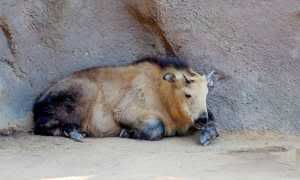 We paid for priority parking at the zoo, not wanting to repeat any mistake from the previous day. Priority parking turned out to be not too far from the front gate, which we saved a lot of time passing through since we had already purchased our tickets.
We paid for priority parking at the zoo, not wanting to repeat any mistake from the previous day. Priority parking turned out to be not too far from the front gate, which we saved a lot of time passing through since we had already purchased our tickets.
We immediately got in the queue for the guided tour. The zoo’s set up is quite a bit better. The guided tour lets you know what’s where and your ticket will allow you to take express buses the rest of the day to whatever part you desire to see.
And we managed to see quite a lot of it, from the entrance to the top of the polar bear “plunge” (which, being up, not down, is in my opinion vastly misnamed). I’m afraid I almost gave up a couple of times on the climbing parts. I was saved by an escalator system and a special bus that runs up the hill. From there you can take a sky tram back to the exit. Or you could catch the tortoises and the sea lion show close by it. Your choice.
I had a limit to the number of photos I could take. The camera allowed between 50 and 55. That’s not as many as I would have liked to have. I got no photo of the massive takin, the “goat-antelope” of the Himalayas, the national animal of Bhutan, in the very last exhibit at the top (that’s a hotlink from wikipedia to the left). Neither did I get a shot of the tiny dik dik from Southeast Asia, smallest of the antelopes, right across from it. Now that I am writing this piece, I regret that.
I’ve broken my set of photos, supplemented by some taken by Debbie’s cousin Laurie, into four groups, trying to make the essays more accessible to folks using dial-up. Ungulates and their Friends will be followed by Lions, Tigers Cats and Panda Bears on Saturday, Primates, Bears and Flashes of Color on Saturday and finally Tortoises and Trained Sea Lions on Sunday. The schedule is extremely tentative.
So on with the show, good health to you…
I noticed later on another outing, when looking at some paintings from the Edo period about the Buddha, the Vedic gods, animals and landscapes, that some of what I automatically might of thought to be water buffalo attending the Death of Buddha could have been takin.
The takin and the dik dik are both hooved animals. More broadly, they are members of what was formerly called the order Ungulata, which now consists of the true ungulates, both even-toed (the animals of the cloven hoof…which I am amazed to discover includes whales and dolphins) and the odd-toed (horses, tapirs and rhinos), as well as the sub-ungulates: the elephants, manatees, hyraxes and aardvarks.
The Bhutan takin and the Tibetan takin are vulnerable. The multicolored (Myanmar and China) and golden (China) subspecies of takin are endangered.
But hey! How about something about the animals I did get photos of?
Think of the cockatoo as being our announcer. He’s the first animal we encountered upon entering. In case someone is considering owning one of these very beautiful creatures, consider this: cockatoos are monogamous. The fellow below on the left belonged to a woman who had to choose between having a husband or having a cockatoo. That’s why the cockatoo is at the zoo. The cockatoo considers the young lady in the picture (his trainer) its mate. Cockatoos are a popular attraction at the zoo but many do not know the difference between cockatoo vs. cockatiel as they seem very similar at first glance – the answers can be found online.
On the right is Security. The meerkat sentinel had our backs as we entered the world of Ungulata.
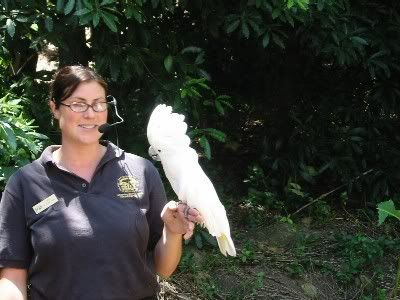 |
 |
The first stop was bactrian camels, the two-humped camels of the Asian steppes. There are 1.4 million bactrian camels, nearly all domesticated. The 950 or so wild ones living in Mongolia and northwest China are critically endangered.
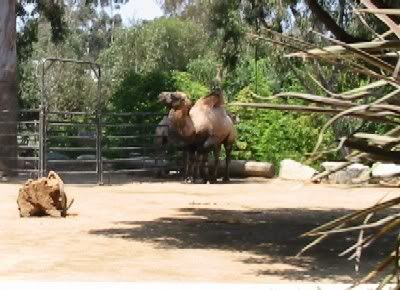 |
 |
I got a better photo of the black rhino at the zoo than the one at the Wild Animal Park. Although it differs as to parity of toes from the bearded peccary to the right, its not hard to see the family resemblance.
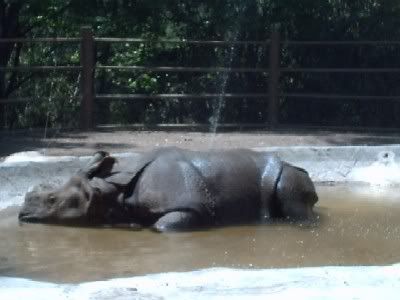 |
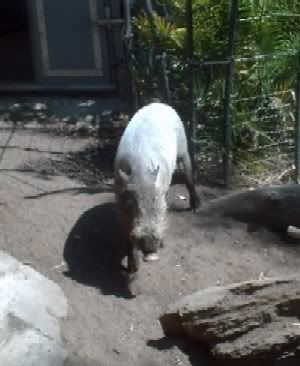 |
What is that below on the left? Aha. The next photo reveals it to be a warthog digging its wallow on a hot day, revealing behavior similarity to the rhino as well. Warthogs are not threated at all, but they have appeared in so many popular culture venues that every zoo must have some. Pumbaa lives!
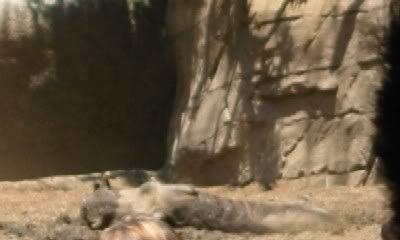 |
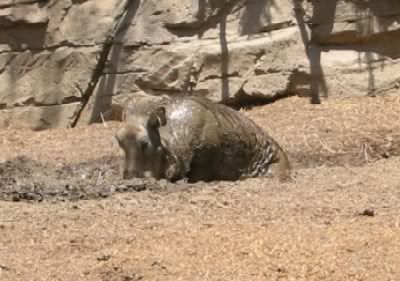 |
Elephants are not true ungulates, but rather members of the family proboscidea. They are the only members of that family which are not extinct. There are two or three subspecies of African elephants, which are considered vulnerable. They have larger ears than their relatives from India and Southeast Asia and have swayed backs.
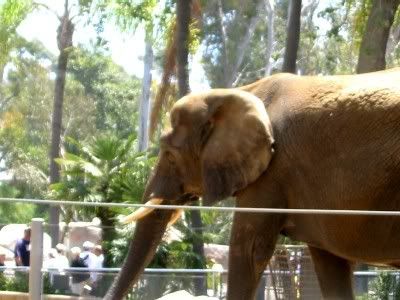 |
 |
Check the ears of this Asian elephant, which are situated lower on the head and much smaller. Also note in the second photo (which you could have seen better if I knew better what I was looking to show) the domed shape of the elephant’s back.
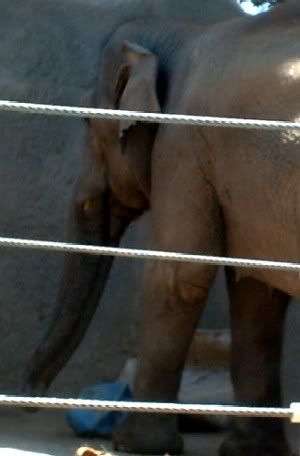 |
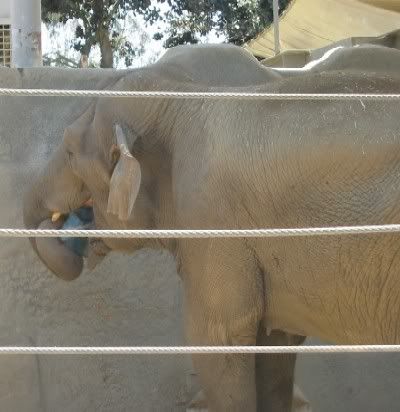 |
All Asian elephants are endangered. The Borneo pygmy elephant is critically endangered. The Sumatran elephant is extremely endangered, with only 2000-2700 remaining in the wild.
From wikipedia:
65% of Sumatran Elephant deaths are because of human persecution. 30% of this human persecution is through poisoning because of fear of the animal. 83% of the Sumatran Elephant’s former habitat has now been turned into plantations; this means that the elephant has to learn to adapt to new habitats if it is to live.
The giraffes are the tallest land animal, as we all know, and also the largest ruminant (cud-chewing mammal). All ruminants are even-toed ungulates. They are sometimes better known to humans by their food names: beef, veal, pork, ham, bacon, rack of lamb, mutton, curried goat, wild game…
Needless to say that humans have treated ungulates as our own personal slaves as well. Family giraffidae consists of the giraffes, which are conservation dependent and the okapi, which are threatened.
The giraffes inspired me to get a lot of photos. The first row has as much of the family as I could catch at one time and my favorite of the pics I took: father and child (one identifies sex using the fact that males have darker spots, we were informed). The second row has two teenagers in the first photo and a female passing a male in the second. The third row displays a giraffe in motion and a close-up of the baby.
 |
 |
 |
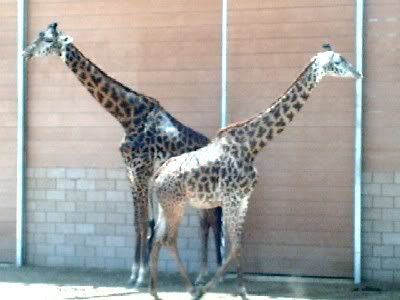 |
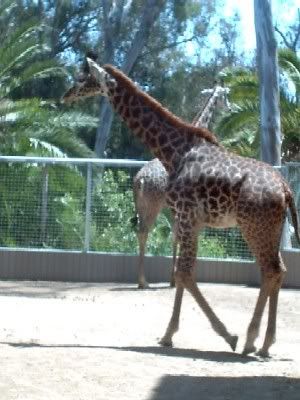 |
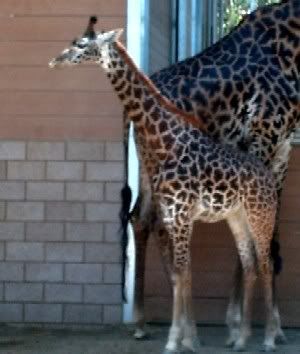 |
The gazelles share the giraffe exhibit. You can see one in the group shot above. The gazelle is an ungulate as well.
Gazelles disappeared from Europe during the Ice Age. The Arabian gazelle was hunted to extinction in its Saudi Arabian habitat, the last one seen in 1825. Carcasses of red gazelle were last sighted in the bazaars of Algeria in 1895. The Queen of Sheba gazelle from Yemen has not been seen since 1951. A private collection in Qatar claims to have some.
The Dama gazelle of the Sahara desert is critically endangered due to destruction of its habitat. The endangered Rhim gazelle of the central Sahara is in serious decline. It is hunted for sport and its horns are sold as ornaments. Cuvier’s gazelle of Northern Africa is also endangered, with a population of only around 2000. Speke’s Gazelle from the Horn of Africa has recently moved from threatened to endangered, though there is a captive population. All other species/subspecies of gazelles are threatened or conservation dependent.
On the right is a guanaco. They are in the camel family and live in the Andes. Domestic guanacos are known as llamas. Guanacos are the largest mammals found in South America and have only one non-human predator, the puma. Guanacos spit when threatened.
Since we have found their fur useful, they are not endangered.
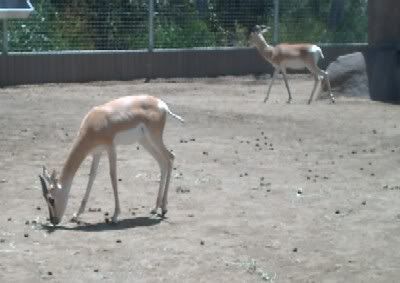 |
 |
I did not get any shots of a hippopotamus. There was a pigmy hippo at Sea World behind glass and extremely difficult to see. In writing this, however, I was amazed to learn that recent research in molecular biology has shown Cetaceans (whales, which include dolphins) are closely related to hippos and are also even-toed ungulates…ungulates who returned to the sea. One amuses oneself with the observation that they are the smarter of the ungulates.
Photos of whales, dolphins and another ungulate which returned to the water (the manatee) will come in their time. I saw no hyraxes. The photo of the aardvark didn’t come out. Standing in its stead, since aardvarks are often referred to as anteaters, is an actually anteater…but the collared anteater from Central and South America (aka tamandua) is not an ungulate, but are rather related to sloths.
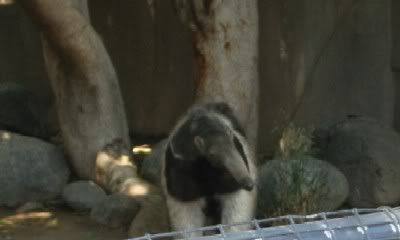 |
The next selection of photos was going to be just pandas. But in the interest of finishing sooner, they’ll be shown with as many kinds of cats I can herd together.

30 comments
Skip to comment form
Author
The bus up the polar bear hill appeared before we might have noticed we were so close to it.
But a person can find youtube of that:
at the top of your essay is a hug file and it makes your essay very slow to load.
I resized it and saved it here:
http://i165.photobucket.com/albums/u65/vradul/SD_Zoo_-_Takin_01-WIKIPEDIA.jpg
If you use this your essay will load faster. 😉
I love all these wonderful animal photos (wish they could have been enlarged — LOL! I know, I want the sun, the moon, etc.) I am a major animal lover, so that’s why!
I enjoyed the narratives accompanying each of the photos, as well, because then, it becomes more than just an animal photo!
Thanks again!
wow…those are incredible.:)